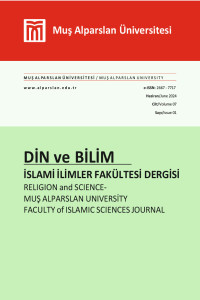Abstract
Vahy’in nüzülünden itibaren Kur’an’ı Kerim anlama faaliyetinin merkezinde olmuştur. Yaşadığı dönemde Kur’an ayetlerinin ne kastettiklerini anlama ihtiyacına Hz. Peygamber tek otorite olarak cevap vermiştir. Sahâbeden itibaren günümüze kadar olan süreçte ise gerek Kur’an’ın dilsel özellikleri, kıraat farklılıkları, çokanlamlılık, gramatik özellikler, muhkem, müteşâbih gibi sebepler gerekse de yaşanan siyasi gelişmeler, itikadi ve fıkhî ayrışmalar Kur’an’nın yorumlanmasında birtakım farklılıklara sebep olmuştur. Buna ilaveten müfessirlerin farklı ilim ve becerileri, siyasal otoriteyle olan münasebetleri ve hepsinden önemlisi aidiyet duygusu gibi bazı özellikler, onları ayetleri yorumlamada farklı yaklaşımlar ortaya koymaya sevk etmiştir. Yazarımız tefsirlere yansıyan bu farklı görüşlerin tarihsel arka planının izini sürmüştür.
Çalışmanın içeriğine geçmeden önce bu kitabın oluşum sürecine değinilmelidir. Bu eser Sağlam’ın da önsöz kısmında ifade ettiği üzere kendisinin 2020 yılında Erciyes Üniversitesi Sosyal Bilimler Enstitüsü’nde hazırladığı “Tefsirlerdeki Farklı Görüşlerin Arka Planı ve Kur’an’ın Anlaşılmasına Yansımaları” başlıklı doktora tezinin kısmen değiştirilerek yayımlanmış şeklidir. ( s.15)
Dört bölümden oluşan kitabın önsöz’ünde eserin ortaya çıkış hikayesi ve yararlanılan mealler zikredilir. Giriş’te çalışmanın konusu, önemi, amacı, kaynakları, yöntemi ve çalışmada başvurulan tefsirlerin kapsam ve sınırları belirtilir. Birinci bölümde Kur’an’nın anlaşılmasıyla ilgili bazı meseleler ve yorumda farklılık konuları üzerinde durulur. İkinci bölümde tefsirlerdeki farklı görüşlerin dilsel ve bağlamsal nedenleri ele alınır. Üçüncü bölümde yorumda meydana gelen yaklaşım farklılıklarının ana nedeni olarak siyasî, itikâdî ve fıkhî kabuller zikredilir. Dördüncü bölümde ise anlam değişmelerinde etkili olan ilmî ve dönemsel sebepler ele alınır. (s. 20 )
References
- Mustafa Sağlam, Tefsirde Anlam Kırılmaları, Fecr Yayınevi, 2022.
Abstract
Since the revelation of Revelation, the Holy Quran has been at the center of the understanding activity. Prophet Muhammad felt the need to understand what the verses of the Quran meant during his time. The Prophet answered as the sole authority. In the process from the Companions to the present day, reasons such as the linguistic features of the Quran, recitation differences, polysemy, grammatical features, muhkam, mutashabih, as well as political developments, religious and fiqh divisions have caused some differences in the interpretation of the Quran. In addition, some characteristics of the commentators, such as their different knowledge and skills, their relations with the political authority and, most importantly, their sense of belonging, have led them to put forward different approaches in interpreting the verses. Our author has traced the historical background of these different views reflected in the commentaries.Before moving on to the content of the study, the creation process of this book should be mentioned. As stated by Sağlam in the foreword, this work is a partially modified and published version of his doctoral thesis titled "The Background of Different Views in Commentaries and Their Reflections on the Understanding of the Quran", which he prepared at Erciyes University Social Sciences Institute in 2020. (p.15)
In the preface of the book, which consists of four chapters, the story of the emergence of the work and the meanings used are mentioned. In the introduction, the subject of the study, its importance, purpose, sources, method, and the scope and limits of the commentaries used in the study are stated. In the first part, some issues related to the understanding of the Quran and differences in interpretation are discussed. In the second part, the linguistic and contextual reasons for the different views in the commentaries are discussed. In the third chapter, political, religious and fiqh assumptions are mentioned as the main reason for the differences in approach in interpretation. In the fourth chapter, scientific and periodic reasons that are effective in meaning changes are discussed. (p. 20)
Keywords
References
- Mustafa Sağlam, Tefsirde Anlam Kırılmaları, Fecr Yayınevi, 2022.
Details
| Primary Language | Turkish |
|---|---|
| Subjects | Tafsir |
| Journal Section | Book Rewiew |
| Authors | |
| Early Pub Date | June 27, 2024 |
| Publication Date | June 30, 2024 |
| Submission Date | April 30, 2024 |
| Acceptance Date | May 18, 2024 |
| Published in Issue | Year 2024 Volume: 7 Issue: 1 |
Contact: dinbil@alparslan.edu.tr
Religion and Science-Muş Alparslan University Faculty of Islamic Sciences Journal is licensed under Creative Commons Attribution-NonCommercial 4.0 International License (CC BY NC).


